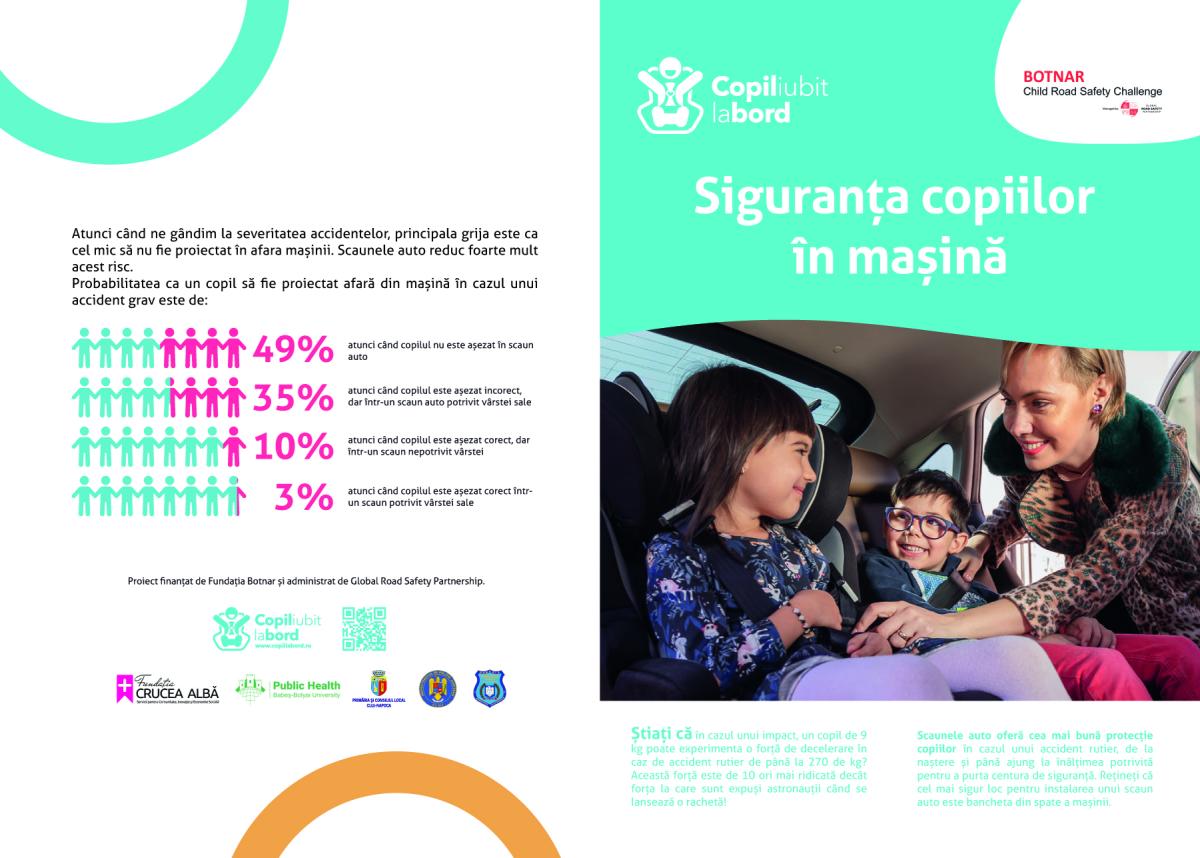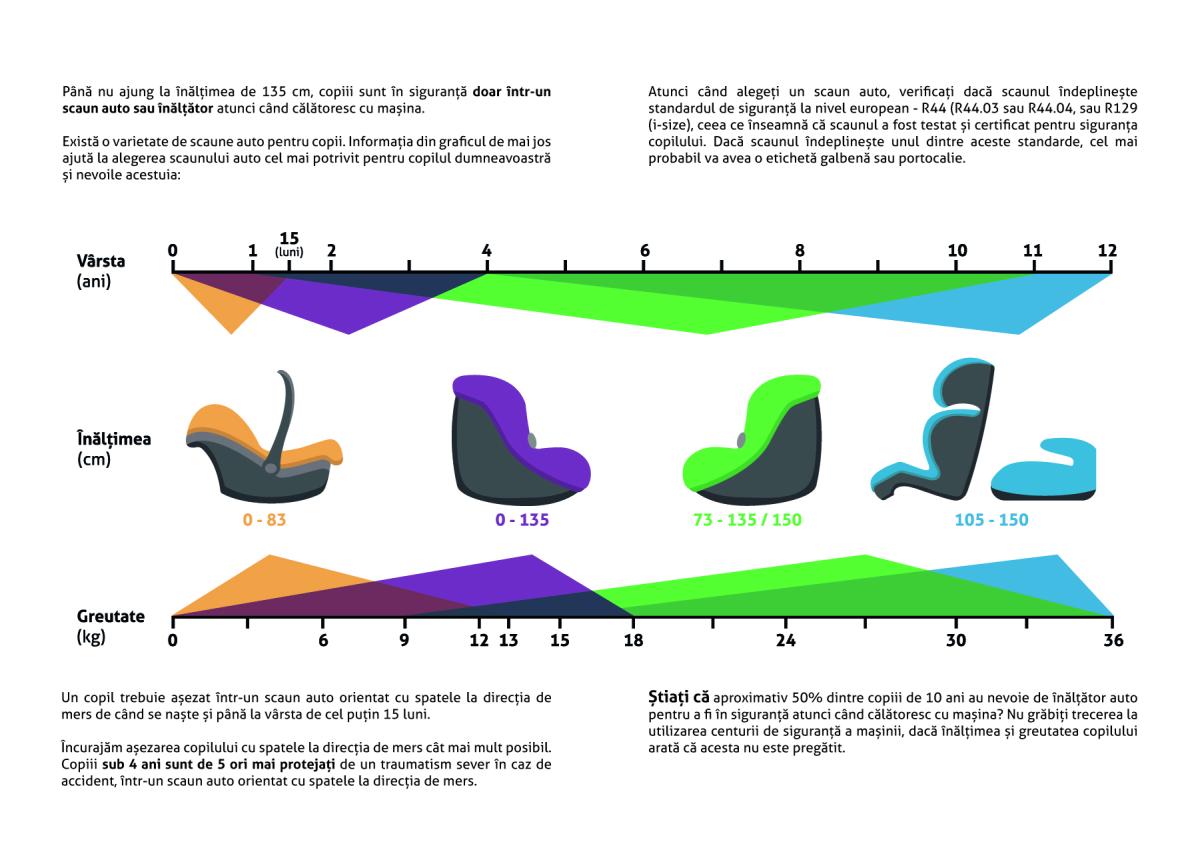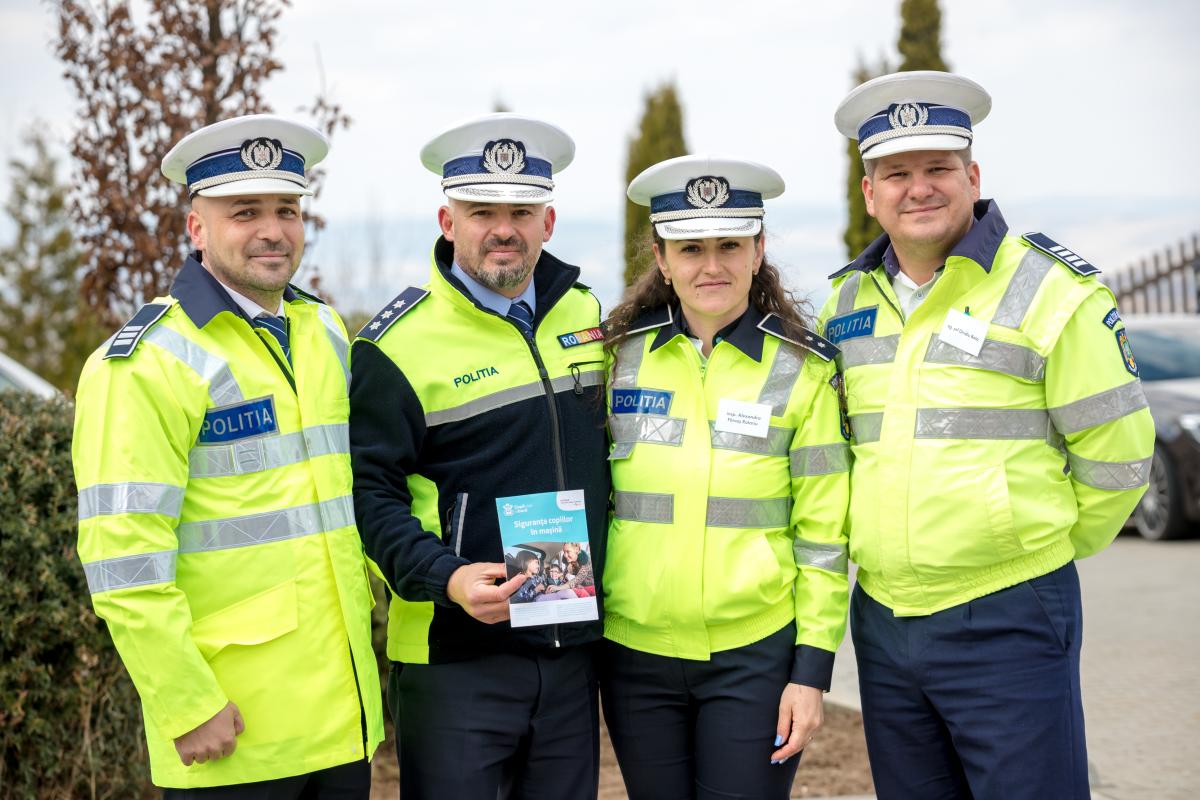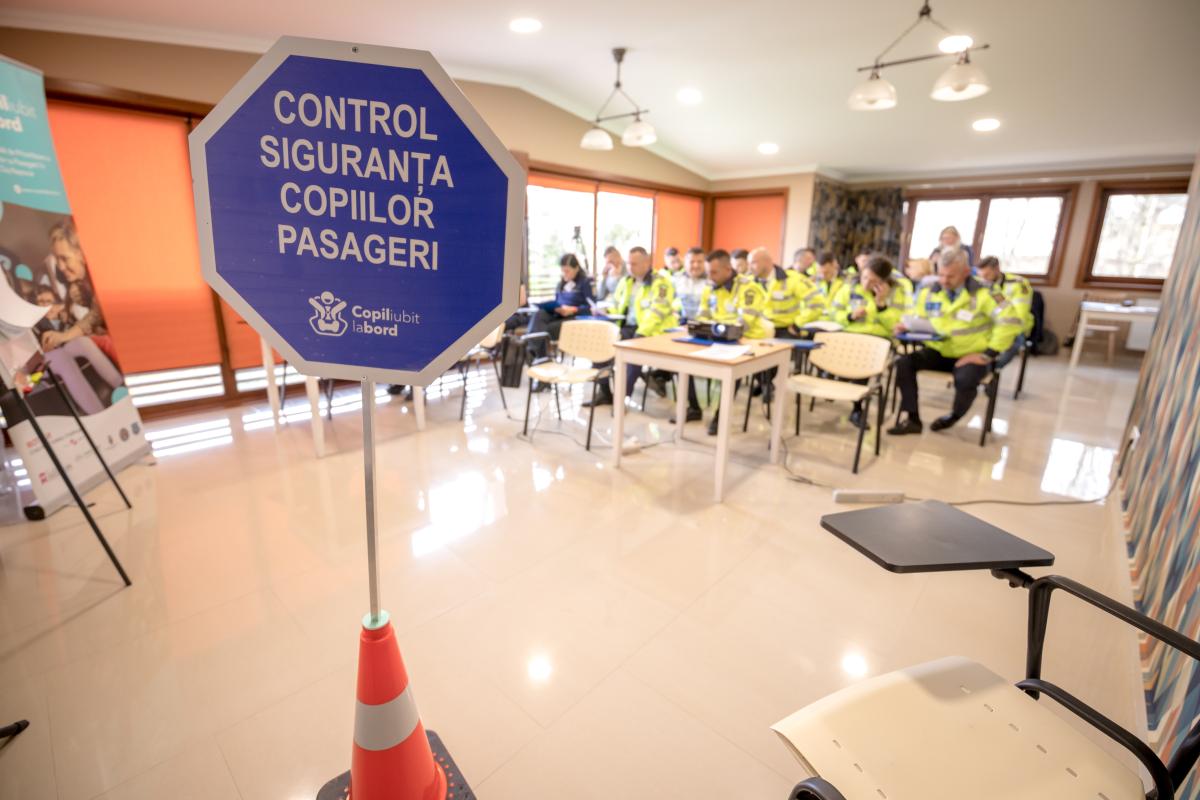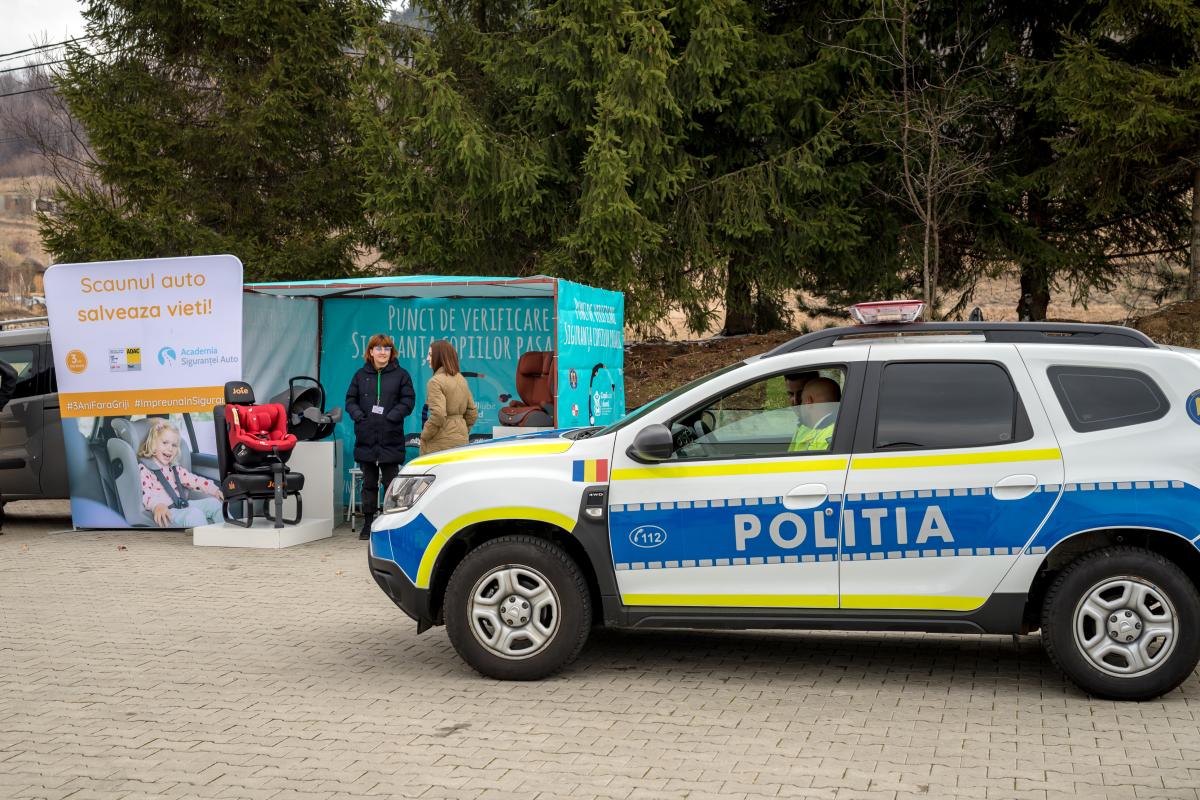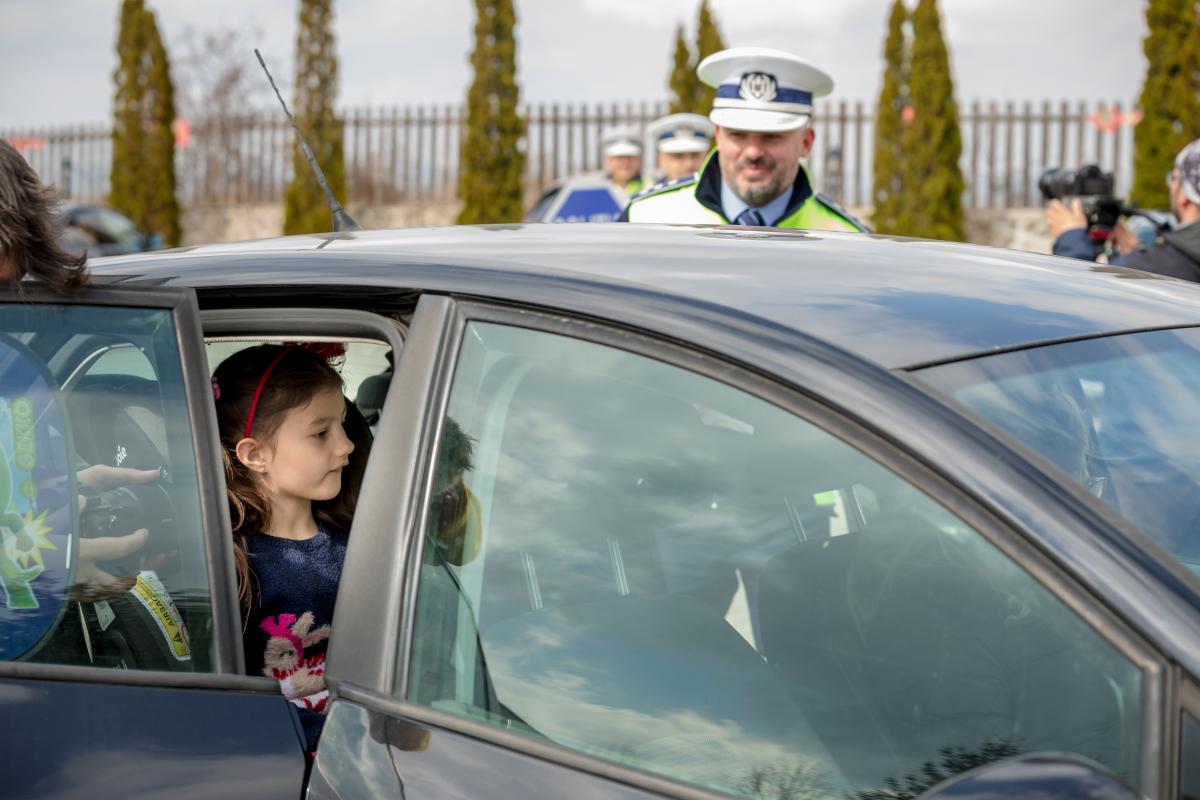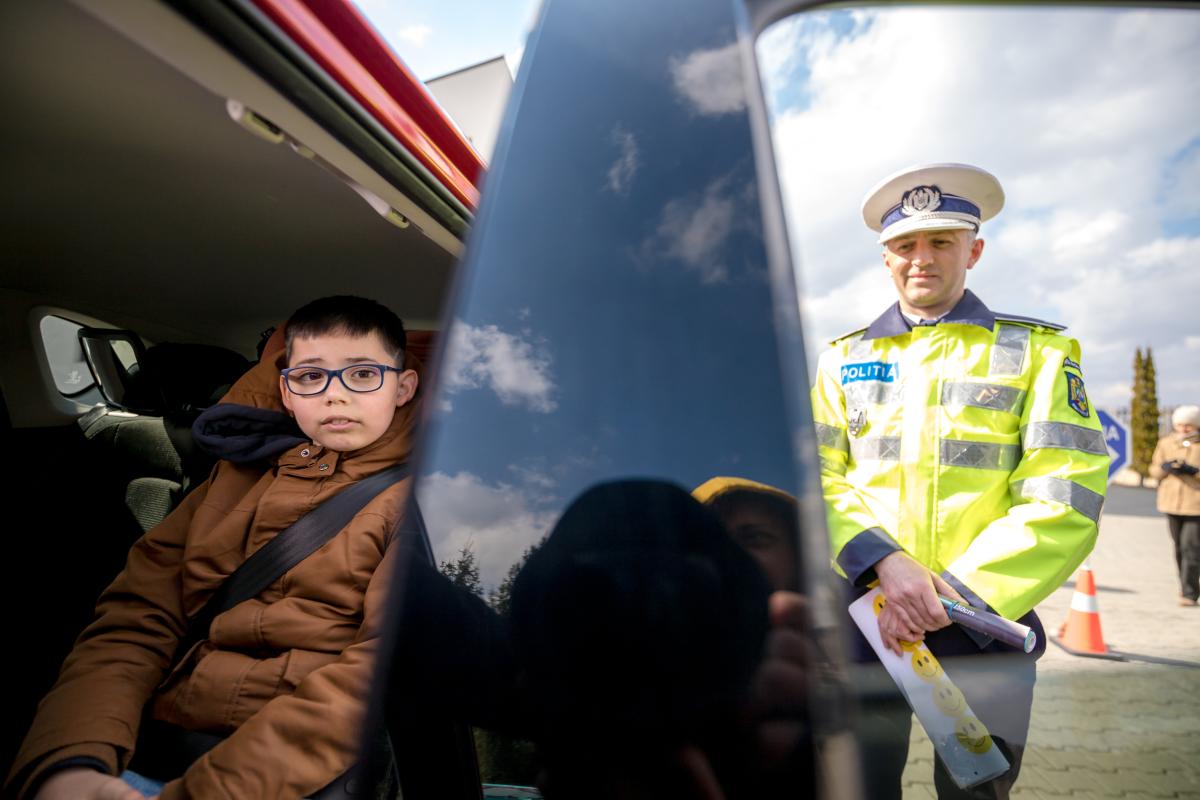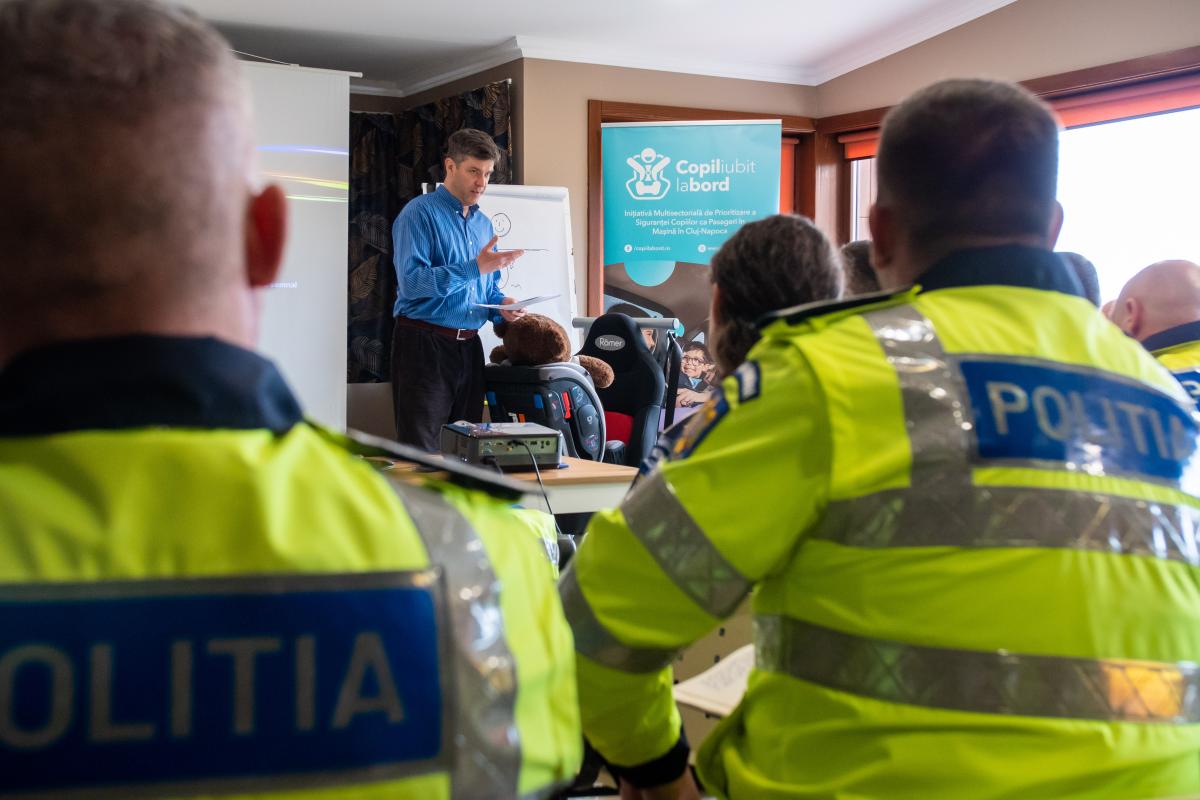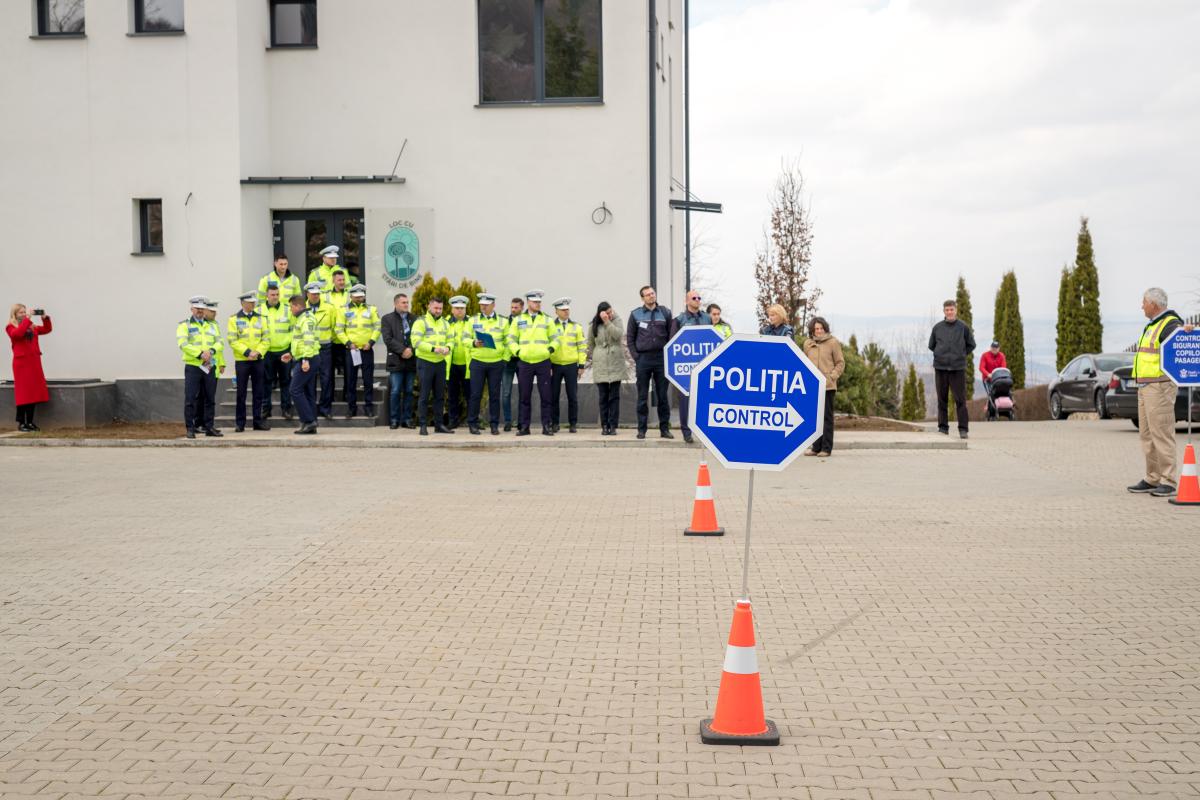Initiative details
One in three children observed in Cluj-Napoca were not wearing any type of restraint compared with, for example a study of 2 652 children in Belgium that found one in five were wearing no restraints. The rates of using restraint in the back seat of a car are generally low in European countries, Romania having the lowest rate of at only 26% (Pan-European Survey Main Results, 2015). The rate of children injured in car crashes and not wearing any type of restraint is high in Cluj-Napoca; police records show that half of the children involved in car crashes were not restraint at the time of the crash, which increases the likelihood of severe injuries and worsen outcomes of crashes.
Injuries, including road traffic injuries, account for 21% of the childhood deaths (0-19 years) in Romania (Mackay & Vincenten, 2012). Specific research conducted in Cluj-Napoca shows that road traffic safety for children should be a concern. A study looking at child patients who suffered head injuries and sought care at Children’s Emergency Hospital Cluj-Napoca (2008-2010), identified that children who suffered a head injury as a consequence of road traffic crash were almost five times more likely to require advanced care (OR: 4.97; 3.09-8.06) than being released (Rus D, Chereches R, Peek-Asa C, et al. 2016). Our data shows that the proportion of parents who used a safety restraint for their children is much lower than reported in most high-income countries. For example, in Australia and the United States of America the proportion of child occupants in restraints is reported as 90% and, 86% (Peden, et al., 2014), respectively, while in Austria, in 2014, the child restraint use rate was almost 99% (Austrian Road Safety Fund, 2014). Child restraint systems are the best way to protect children as passengers in a car, and currently Romania has a specific legislation to foresee the correct use of child safety restraints (CSR), but to our knowledge, no specific programs have been implemented at the local level to increase correct CSR use by increasing the enforcement of the existing legislation.
In line with the EU regulations, the Romanian Traffic Code was changed in September 2014 to include penalties for drivers who do not secure underage passengers with seatbelt or child safety restraints. Further modifications were enacted in 2015, requiring that children under the age of three or whose height does not exceed 135 cm should travel in a child safety seat, while older children should use seatbelts appropriately adjusted for their weight and height.
All these requirements were implemented at the request of DIRECTIVE 2014/37/EU on use of safety belts and child restraint systems in vehicles. The project will focus on correct use of CSR using evidence-based strategies, documented at local level by the proposed academic partners and in line with the prevention strategies set in the Decade for Action on Road Safety 2011-2020 of the WHO and its’ subsequent 10 prevention strategies targeting children.
Data collected as part of an observational study (2013-2014) shows that in Cluj-Napoca, one third (32.6%) of child passengers between the ages of 0-17 were not wearing any type of restraints when observed (Rus, 2015; Rus, Peek-Asa, Jurchis, & Chereches, 2016). The rates of non-restraints increased with age, children older than five years being less likely to be restraint when travelling in a car (Rus, 2015). Additionally, a qualitative study was conducted to further explore parents’ perceptions, behaviours and decisions regarding the use of child safety restraints in Cluj-Napoca (2016). In this second study, parents acknowledged the role of police officers in education and raising awareness among two groups: parents and children.
Police officers were perceived as key stakeholders in education on road traffic safety Police data. Cluj County Police Data (2015-2016) shows that more than 300 children between the ages of 0 and 3 were involved in a road traffic crash as car passengers. In 2015, 322 children under the age of 3 were involved in a road traffic crash as car passengers, out of which 148 (45.9%) were not wearing any type of restraint. The percentage was almost the same for 2016, 159 (45.2%) out of 352, children under the age of 3 involved in road traffic crash as car passengers were not wearing any type of restraints.
Injuries, including road traffic injuries, account for 21% of the childhood deaths (0-19 years) in Romania (Mackay & Vincenten, 2012). Specific research conducted in Cluj-Napoca shows that road traffic safety for children should be a concern. A study looking at child patients who suffered head injuries and sought care at Children’s Emergency Hospital Cluj-Napoca (2008-2010), identified that children who suffered a head injury as a consequence of road traffic crash were almost five times more likely to require advanced care (OR: 4.97; 3.09-8.06) than being released (Rus D, Chereches R, Peek-Asa C, et al. 2016). Our data shows that the proportion of parents who used a safety restraint for their children is much lower than reported in most high-income countries. For example, in Australia and the United States of America the proportion of child occupants in restraints is reported as 90% and, 86% (Peden, et al., 2014), respectively, while in Austria, in 2014, the child restraint use rate was almost 99% (Austrian Road Safety Fund, 2014). Child restraint systems are the best way to protect children as passengers in a car, and currently Romania has a specific legislation to foresee the correct use of child safety restraints (CSR), but to our knowledge, no specific programs have been implemented at the local level to increase correct CSR use by increasing the enforcement of the existing legislation.
In line with the EU regulations, the Romanian Traffic Code was changed in September 2014 to include penalties for drivers who do not secure underage passengers with seatbelt or child safety restraints. Further modifications were enacted in 2015, requiring that children under the age of three or whose height does not exceed 135 cm should travel in a child safety seat, while older children should use seatbelts appropriately adjusted for their weight and height.
All these requirements were implemented at the request of DIRECTIVE 2014/37/EU on use of safety belts and child restraint systems in vehicles. The project will focus on correct use of CSR using evidence-based strategies, documented at local level by the proposed academic partners and in line with the prevention strategies set in the Decade for Action on Road Safety 2011-2020 of the WHO and its’ subsequent 10 prevention strategies targeting children.
Data collected as part of an observational study (2013-2014) shows that in Cluj-Napoca, one third (32.6%) of child passengers between the ages of 0-17 were not wearing any type of restraints when observed (Rus, 2015; Rus, Peek-Asa, Jurchis, & Chereches, 2016). The rates of non-restraints increased with age, children older than five years being less likely to be restraint when travelling in a car (Rus, 2015). Additionally, a qualitative study was conducted to further explore parents’ perceptions, behaviours and decisions regarding the use of child safety restraints in Cluj-Napoca (2016). In this second study, parents acknowledged the role of police officers in education and raising awareness among two groups: parents and children.
Police officers were perceived as key stakeholders in education on road traffic safety Police data. Cluj County Police Data (2015-2016) shows that more than 300 children between the ages of 0 and 3 were involved in a road traffic crash as car passengers. In 2015, 322 children under the age of 3 were involved in a road traffic crash as car passengers, out of which 148 (45.9%) were not wearing any type of restraint. The percentage was almost the same for 2016, 159 (45.2%) out of 352, children under the age of 3 involved in road traffic crash as car passengers were not wearing any type of restraints.
Initiative date
to
Who was/is your target audience?
Policy makers
Public authorities
Children 0-16
Adults
Parents
Seniors
Emergency services
Topic
Knowledge building and sharing
Create awareness
Organisation details
FUNDATIA CRUCEA ALBA
Association
Romania
Cluj Napoca
Contact name
Ana Maita
Telephone number
0040745910207
office@cruceaalba.ro
Website link
Project activities
If you work together with external partners, list the most important partners and briefly describe their role.
Department of Public Health, Babes-Bolyai University (UBB). As part of the Department’s Violence and Injury Prevention Unit (VIP), Dr. Diana Dulf, carries out violence and injury prevention research and public health policy in Romania. Dr. Dulf has extensive experience initiating studies on road traffic safety based on the high burden of road traffic injuries in Romania, leading studies on child injuries and safety and implementing research and practice as part of international consortium. In the field of road traffic safety, the research staff has mainly worked with data sets from the emergency department and police department and concentrating on injury epidemiology.
Cluj-Napoca City Hall was involved in the coordination of activities at the local government, assisted with the activities involving traffic and community police and contributed to the development and dissemination of printed materials.
The Cluj-Napoca Road Traffic Police supported the implementation of tailored training seminars for road traffic police officers and organized strategic enforcement efforts to apply learnings from the trainings.
Fondation Botnar is a Swiss philanthropic foundation working to improve the health and wellbeing of young people living in cities around the world. Advocating for the inclusion of youth voices and the equitable use of AI and digital technology the foundation invests in and supports innovative programs and research, and brings together actors from across sectors to create dialogue and partnerships.
The Global Road Safety Partnership (GRSP) is a non-profit organization that was formed in 1999 in response to global recognition of road crash deaths and injuries as a human-made health crisis. Hosted by the International Federation of the Red Cross and Red Crescent Societies (IFRC) its role is to create and support multi-sector road safety partnerships that are engaged with front-line good practice road safety interventions in countries and communities throughout the world. We play a powerful role in capacity building and training of road safety practitioners and traffic police, engage actively in advocacy at all levels, provide road safety programme coordination at the global level, and are a recognised expert source of road safety knowledge and good practice.
Cluj-Napoca City Hall was involved in the coordination of activities at the local government, assisted with the activities involving traffic and community police and contributed to the development and dissemination of printed materials.
The Cluj-Napoca Road Traffic Police supported the implementation of tailored training seminars for road traffic police officers and organized strategic enforcement efforts to apply learnings from the trainings.
Fondation Botnar is a Swiss philanthropic foundation working to improve the health and wellbeing of young people living in cities around the world. Advocating for the inclusion of youth voices and the equitable use of AI and digital technology the foundation invests in and supports innovative programs and research, and brings together actors from across sectors to create dialogue and partnerships.
The Global Road Safety Partnership (GRSP) is a non-profit organization that was formed in 1999 in response to global recognition of road crash deaths and injuries as a human-made health crisis. Hosted by the International Federation of the Red Cross and Red Crescent Societies (IFRC) its role is to create and support multi-sector road safety partnerships that are engaged with front-line good practice road safety interventions in countries and communities throughout the world. We play a powerful role in capacity building and training of road safety practitioners and traffic police, engage actively in advocacy at all levels, provide road safety programme coordination at the global level, and are a recognised expert source of road safety knowledge and good practice.
Please describe the project activities you carried/are carrying out and the time period over which these were implemented.
2018- 2022
Objective 1: Strengthen and increase enforcement of seat-belts and child restraint requirements in Cluj-Napoca
Strategy 1.1. Coordinate the work of a Multi-Disciplinary Working Group of stakeholders
Activity 1.1.1 Identify and map relevant stakeholder in Cluj
Identify and map local stakeholders active in the field of road traffic safety, child health and safety, and child safety products from the public, private and NGO sectors.
A comprehensive mapping of stakeholders, complete with their respective communication outlets with the community was crucial for building a strong support base for the project and to create a wide, ready-to-use channel of communication with as large a community as possible.
Activity 1.1.2 Coordinate the work of the Multi-Disciplinary Working Group
Establish a Multi-Disciplinary Working Group
The multi-disciplinary group was tasked with maintaining 360o overview of the project, reviewing progress and results and suggesting optimizing and corrective actions. The formal format of the Working Group as well as its long-term reach was intended to maintain the active involvement and commitment from all the stakeholders.
Strategy 1.2. Strengthen commitment from Road Traffic Police Department to support seat-belt and CRS enforcement
The engagement with the traffic and community police was coordinated by the Police Engagement Coordinator. This included communication, coordination and assisting in conducting the assessment, development of the enforcement plan, etc.
Activity 1.2.1: Secure commitment from police to support the project and conduct targeted enforcement of seat-belt and CRS use.
FCA, along with the Police Engagement Coordinator, met with the high commissioner of the Cluj City Police and his managerial staff to provide an explanation of the project and the proposed activities. The police then provided their written commitment to participating in the project (including a commitment to dedicate policing human resources for targeted enforcement activities on seat-belt and CRS use.) As part of this commitment, project staff requested crash data from the police as well as existing seat-belt/CRS enforcement operations, and established a data sharing agreement with the police.
Activity 1.2.2 – Analysis of crash and seat-belt/CRS enforcement data
Data from police was analysed by UBB consultants to establish a baseline assessment of compliance and enforcement indicators. This included a review of available crash data (by age of victims, causality) and enforcement data (citations issued, checkpoints, compliance data from police, etc.) Additional police data analysis was conducted on a quarterly basis to assess progress of the enforcement activity and compliance rates.
Activity 1.2.3 Conduct a police capacity assessment. The capacity assessment of police operations included meetings with selected officers to further identify their:
- organizational, human, technological resources
- current enforcement strategies and tactics for seat-belt and CRS enforcement
- existing trainings and its focus
- data system
- existing equipment, usage and quality (if needed)
The assessment methodology was provided by GRSP. The results of the capacity assessment was presented to the Police Commissioners as well as the outline of a suggested training program and any equipment requirements
Activity 1.2.4 Conduct capacity training for police (plan, design, and conduct one 2 to 5-day best practice capacity building training on seat-belt and CRS enforcement) The training wascomprised of 5-6 sessions, including a session of road site coaching. The trainings were delivered by an International Police Trainer and took place at a relevant police venue in Romania. GRSP developed the content of the training program and supported consortium members in liaising with the police on training delivery, equipment procurement, etc. GRSP covered the costs of the trainer and provided the methodology and all materials used for the training. The training was delivered to 50 police officers.
Activity 1.2.5 Coordinate meetings with traffic police to develop targeted enforcement action on seat-belt and CRS use. The Police Engagement Coordinator and key members of the working group met with the police along a span of three months to develop a enforcement action plan on seat-belt and CRS use. The group discussed challenges, proposed scheduled of road site actions and locations, resources needed using good practice examples. GRSP provided limited technical assistance on the development of the action plan as well as best practice examples.
Activity 1.2.6 Training of traffic police officers and community police officers on CRS fitting
To support the implementation of enforcement activities, FCA trained, with the help of an internationally accredited Road Safety Trainer a cohort of traffic police officers on proper CRS fitting. The 1-2 day training focused on the role of traffic police officers in increasing knowledge and awareness of drivers on CRS, risk factor information and proper installation and inspection of CRS. The trained police officers then played a central role in roadside checkpoints of CRS use as part of the enforcement action plan.
Community police officers have a stronger presence at the local level. To better capitalize on their role, FCA included them in the training for proper CRS use in order to prepare community policy officers in providing minimal support on CRS and seatbelt use to drivers in the neighbourhoods they work in, and proper installation of CRS.
Activity 1.2.8 Media Launch of the Enforcement Action Plan
FCA, the Police Engagement Coordinator and the project working group worked with the Police to develop a media launch of the enforcement action plan.
Activity 1.2.9 Support Traffic Police to implement the Enforcement Action Plan.
Traffic police implemented the enforcement action plan.
Objective 1: Strengthen and increase enforcement of seat-belts and child restraint requirements in Cluj-Napoca
Strategy 1.1. Coordinate the work of a Multi-Disciplinary Working Group of stakeholders
Activity 1.1.1 Identify and map relevant stakeholder in Cluj
Identify and map local stakeholders active in the field of road traffic safety, child health and safety, and child safety products from the public, private and NGO sectors.
A comprehensive mapping of stakeholders, complete with their respective communication outlets with the community was crucial for building a strong support base for the project and to create a wide, ready-to-use channel of communication with as large a community as possible.
Activity 1.1.2 Coordinate the work of the Multi-Disciplinary Working Group
Establish a Multi-Disciplinary Working Group
The multi-disciplinary group was tasked with maintaining 360o overview of the project, reviewing progress and results and suggesting optimizing and corrective actions. The formal format of the Working Group as well as its long-term reach was intended to maintain the active involvement and commitment from all the stakeholders.
Strategy 1.2. Strengthen commitment from Road Traffic Police Department to support seat-belt and CRS enforcement
The engagement with the traffic and community police was coordinated by the Police Engagement Coordinator. This included communication, coordination and assisting in conducting the assessment, development of the enforcement plan, etc.
Activity 1.2.1: Secure commitment from police to support the project and conduct targeted enforcement of seat-belt and CRS use.
FCA, along with the Police Engagement Coordinator, met with the high commissioner of the Cluj City Police and his managerial staff to provide an explanation of the project and the proposed activities. The police then provided their written commitment to participating in the project (including a commitment to dedicate policing human resources for targeted enforcement activities on seat-belt and CRS use.) As part of this commitment, project staff requested crash data from the police as well as existing seat-belt/CRS enforcement operations, and established a data sharing agreement with the police.
Activity 1.2.2 – Analysis of crash and seat-belt/CRS enforcement data
Data from police was analysed by UBB consultants to establish a baseline assessment of compliance and enforcement indicators. This included a review of available crash data (by age of victims, causality) and enforcement data (citations issued, checkpoints, compliance data from police, etc.) Additional police data analysis was conducted on a quarterly basis to assess progress of the enforcement activity and compliance rates.
Activity 1.2.3 Conduct a police capacity assessment. The capacity assessment of police operations included meetings with selected officers to further identify their:
- organizational, human, technological resources
- current enforcement strategies and tactics for seat-belt and CRS enforcement
- existing trainings and its focus
- data system
- existing equipment, usage and quality (if needed)
The assessment methodology was provided by GRSP. The results of the capacity assessment was presented to the Police Commissioners as well as the outline of a suggested training program and any equipment requirements
Activity 1.2.4 Conduct capacity training for police (plan, design, and conduct one 2 to 5-day best practice capacity building training on seat-belt and CRS enforcement) The training wascomprised of 5-6 sessions, including a session of road site coaching. The trainings were delivered by an International Police Trainer and took place at a relevant police venue in Romania. GRSP developed the content of the training program and supported consortium members in liaising with the police on training delivery, equipment procurement, etc. GRSP covered the costs of the trainer and provided the methodology and all materials used for the training. The training was delivered to 50 police officers.
Activity 1.2.5 Coordinate meetings with traffic police to develop targeted enforcement action on seat-belt and CRS use. The Police Engagement Coordinator and key members of the working group met with the police along a span of three months to develop a enforcement action plan on seat-belt and CRS use. The group discussed challenges, proposed scheduled of road site actions and locations, resources needed using good practice examples. GRSP provided limited technical assistance on the development of the action plan as well as best practice examples.
Activity 1.2.6 Training of traffic police officers and community police officers on CRS fitting
To support the implementation of enforcement activities, FCA trained, with the help of an internationally accredited Road Safety Trainer a cohort of traffic police officers on proper CRS fitting. The 1-2 day training focused on the role of traffic police officers in increasing knowledge and awareness of drivers on CRS, risk factor information and proper installation and inspection of CRS. The trained police officers then played a central role in roadside checkpoints of CRS use as part of the enforcement action plan.
Community police officers have a stronger presence at the local level. To better capitalize on their role, FCA included them in the training for proper CRS use in order to prepare community policy officers in providing minimal support on CRS and seatbelt use to drivers in the neighbourhoods they work in, and proper installation of CRS.
Activity 1.2.8 Media Launch of the Enforcement Action Plan
FCA, the Police Engagement Coordinator and the project working group worked with the Police to develop a media launch of the enforcement action plan.
Activity 1.2.9 Support Traffic Police to implement the Enforcement Action Plan.
Traffic police implemented the enforcement action plan.
Evaluation
What has been the effect of the activities?
Children are at high risk when travelling as car passengers in Romania. An increase in CRS usage was observed between 2014 (75.3%) - and 2018 (85.8%) in Cluj-Napoca, according to the data collected by the research team from UBB in these years.
In the 2018 survey, 85.8% of surveyed parents had children restrained when traveling in the car. Taking into consideration the Romanian legislation, correct CRS use was identified in 80.6% of restrained children (aged between less than one year old, up to 14 years old). 5% were incorrectly restraint and 15% not restraint at all. Yet, the graph below shows that these rates of properly used CRSs decrease as age increases from 3 to 14 years old (from 89.3% of correct usage in infants and toddlers to 62.2% of correct usage in primary school children).
In 2018 18.6% of the parents mentioned that their child does not need a CRS due to the fact that it is already too tall/old enough whilst another 18.6% of the parents did not move their CRS from the other vehicle they own. Almost one tenth of the respondents (8.8%) considered having a child in an adult’s lap to be a safe behaviour as well. As identified in Phase I of the project, Police Crash Data Reports for 2018 show that half of the children involved in car crashes in Cluj-Napoca are not wearing any type of restraints and the proportion of older children (between 8-17 years) who travel unrestrained increases by age. Based on the data collected using observations and surveys between November 2019 and February 2020 (covering 4 months of data; N=370), the percentage of older children travelling unrestrained is 24.55%. Information from the local Road Traffic Police department shows that 38.1% of the children involved in car crashes in 2020 were not restrained.
As of 2019, 13.2% of children were not restraint at all and 7.4% were inappropriately restraint. Additionally, the data presents some reasons due to which the parents chose not to use CRS when travelling with their children:
Yet, the same parents would be motivated to start using a CRS because of their child’s safety (44.1%), because of the law (5.9%), because of the age of their child (5.9%) or because of the fine (2.9%), whilst the rest did not know or were undecided.
Based on all these aspects, efforts should be focused around enforcement and strengthening the awareness regarding this topic(including education for parents focused on mythbusters), as parents and children tend to use less the CRS as children age.
Evaluation of compliance and public awareness activities was always a consistent focus of our project. To fully evaluate the impact of our activities a series of steps:
Conduct training for data collectors engaged in the observational studies (UBB organized trainings for data collectors engaged in the seat-belt and CRS use observational studies and KAP surveys)
> Conduct observational studies of seat-belt and CRS use (UBB conducted independent observational studies on seat-belt and CRS use: 3 during the course of 2018-2020 phase of the project: beginning, middle, and the end of the project).
> Conduct KAP surveys (UBB carried out ‘’Knowledge, Attitudes and Practices’’ surveys of parents to measure knowledge of CRS requirements, awareness of police enforcement activities, reasons for using/not using CRS, among others at the beginning, mid point, and end of phase 2018-2020 of the project)
- 12 road traffic enforcement activities , 50 agents, 260 cars stopped and checked
- 4 capacity building trainings for Traffic Police officers for 50 road police agents and local police agents
- 375 surveys completed by ata collectors from the Public Health department and by the police officers.
- 660 parents and children participated in 5 educational and awareness activities
- Educational and awareness info reached over 10000 Social Media Users
In the 2018 survey, 85.8% of surveyed parents had children restrained when traveling in the car. Taking into consideration the Romanian legislation, correct CRS use was identified in 80.6% of restrained children (aged between less than one year old, up to 14 years old). 5% were incorrectly restraint and 15% not restraint at all. Yet, the graph below shows that these rates of properly used CRSs decrease as age increases from 3 to 14 years old (from 89.3% of correct usage in infants and toddlers to 62.2% of correct usage in primary school children).
In 2018 18.6% of the parents mentioned that their child does not need a CRS due to the fact that it is already too tall/old enough whilst another 18.6% of the parents did not move their CRS from the other vehicle they own. Almost one tenth of the respondents (8.8%) considered having a child in an adult’s lap to be a safe behaviour as well. As identified in Phase I of the project, Police Crash Data Reports for 2018 show that half of the children involved in car crashes in Cluj-Napoca are not wearing any type of restraints and the proportion of older children (between 8-17 years) who travel unrestrained increases by age. Based on the data collected using observations and surveys between November 2019 and February 2020 (covering 4 months of data; N=370), the percentage of older children travelling unrestrained is 24.55%. Information from the local Road Traffic Police department shows that 38.1% of the children involved in car crashes in 2020 were not restrained.
As of 2019, 13.2% of children were not restraint at all and 7.4% were inappropriately restraint. Additionally, the data presents some reasons due to which the parents chose not to use CRS when travelling with their children:
Yet, the same parents would be motivated to start using a CRS because of their child’s safety (44.1%), because of the law (5.9%), because of the age of their child (5.9%) or because of the fine (2.9%), whilst the rest did not know or were undecided.
Based on all these aspects, efforts should be focused around enforcement and strengthening the awareness regarding this topic(including education for parents focused on mythbusters), as parents and children tend to use less the CRS as children age.
Evaluation of compliance and public awareness activities was always a consistent focus of our project. To fully evaluate the impact of our activities a series of steps:
Conduct training for data collectors engaged in the observational studies (UBB organized trainings for data collectors engaged in the seat-belt and CRS use observational studies and KAP surveys)
> Conduct observational studies of seat-belt and CRS use (UBB conducted independent observational studies on seat-belt and CRS use: 3 during the course of 2018-2020 phase of the project: beginning, middle, and the end of the project).
> Conduct KAP surveys (UBB carried out ‘’Knowledge, Attitudes and Practices’’ surveys of parents to measure knowledge of CRS requirements, awareness of police enforcement activities, reasons for using/not using CRS, among others at the beginning, mid point, and end of phase 2018-2020 of the project)
- 12 road traffic enforcement activities , 50 agents, 260 cars stopped and checked
- 4 capacity building trainings for Traffic Police officers for 50 road police agents and local police agents
- 375 surveys completed by ata collectors from the Public Health department and by the police officers.
- 660 parents and children participated in 5 educational and awareness activities
- Educational and awareness info reached over 10000 Social Media Users
Please briefly explain why your initiative is a good example of improving road safety.
Our recipe for success is the multi-stakeholders’ engagement. Our conviction based on sound research is that it takes a village to raise a child, it takes a community to protect them. By mobilizing all the stakeholders that are relevant for this issue we managed to tackle the solving of the issue with a 360 degree approach. We piloted this approach at local level in Cluj Napoca, tested and optimized all our assumptions and established a best practice case that now can be readily scaled up to national level. The formal research component was key to this and can also be replicated.
So far, under the project, we have built a multi-sectoral group of stakeholders who collaborate to increase child road traffic safety as car passengers. Both public and private institutions are collaborating to increase the correct use of child safety restraint from different directions: enforcement of CRS laws, engineering - development of a car seat safety app (launch on July 7th), education - raising awareness activities and access to support services: First Car Seat Incentive Program (planning phase) and Car Seat Check Program (planning phase).
So far, under the project, we have built a multi-sectoral group of stakeholders who collaborate to increase child road traffic safety as car passengers. Both public and private institutions are collaborating to increase the correct use of child safety restraint from different directions: enforcement of CRS laws, engineering - development of a car seat safety app (launch on July 7th), education - raising awareness activities and access to support services: First Car Seat Incentive Program (planning phase) and Car Seat Check Program (planning phase).
How have you shared information about your project and its results?
One of our main objectives was to increase compliance with child restraint and seat-belt use requirements through public awareness and the strategy we relied on was to strengthen and increase the information available on the use of seat-belts and CRS requirements through the media. We achieved that by taking several steps:
>> Media training
A media training event organized for approximately 20 journalists in the first 2 years of the project and covered risk factor information, the role of media covers CRS/seat-belt issues as safety advocates. The trained media professionals’ activity was monitored for six months after the training to evaluate the implementation of the knowledge and skills build during the training in their every-day media sharing on the topic of road traffic safety.
>> Providing regular updates and content to media
Stories, facts, news on children’s safety, with an emphasis on seat-belts and child restraint requirements were regularly pitched to local media in Cluj-Napoca.
A media breakfast was held every two months with 4-5 selected journalists from the trained media professionals.
Child car safety informational materials and boilerplates were provided to media outlets to be included in all accounts of traffic incidents. Materials were shared with media that were developed with input from GRSP.
>> Media Monitoring
Frequency and quality of media coverage of seat-belts and CRS use in Cluj Napoca were monitored through a monthly media monitoring contractual services. News and events linked to the project were regularly reported in the local media.
Another strategy we used was to conduct a Public Awareness Campaign on child-passenger car safety. “The 3 A’s Campaign- Așezat, asigurat, ancorat. Pe drumuri către viitor” (“The 3 S’s Campaign- Seated, safe, secured. On road to the future”) which comprised the following steps:
> Development and dissemination of PSAs
FCA, in consultation with the Cluj Napoca City Hall, agreed the subject and the dissemination plan for PSAs. FCA consulted with GRSP on the message and content of the PSA. A consulting company was engaged to test the message through focus group (10-12 target group representatives) discussions and develop the PSAs based on what is being assessed to be the most effective message and content.
The PSA (targeted at parents of 4-12 year olds ) were then pitched to and approved by the National Council for Radio and Television Broadcasters and promptly disseminated nationally via TV and radio stations. Content was focus on the safety and legal implications of using a car seat for children rather than on parental competence since the social value of parental competence still ranks lower than legal compliance.
> Development of printed materials on CRS
The prints included a child safety passengers guide, leaflets, brochures, posters.
As with the PSA, the content addressed the safety and legal implications of CRS use for children, as well as appropriate CRS use by age/height.
The prints was distributed via the commercial and institutional partners: a) traffic police officers (as part of the enforcement activities), b) in primary schools, c) community police officers and c) in gas stations; d) hospitals and medical facilities; e) car dealerships; f) insurance agencies.
> Online dissemination of information
FCA worked together with the project partners to develop a website/page that builds on the information provided in the printed materials, and provides in-depth content the importance of CRS use, the legal requirements of their use, how to determine the product’s certification, and appropriate CRS use by age/height.
Setting up and using diverse Social Media outlets (Facebook, Instagram, YouTube, Twitter, Linkedin) was paramount to our successful communication of the project activities and results both in Romanian and in English.
>> Media training
A media training event organized for approximately 20 journalists in the first 2 years of the project and covered risk factor information, the role of media covers CRS/seat-belt issues as safety advocates. The trained media professionals’ activity was monitored for six months after the training to evaluate the implementation of the knowledge and skills build during the training in their every-day media sharing on the topic of road traffic safety.
>> Providing regular updates and content to media
Stories, facts, news on children’s safety, with an emphasis on seat-belts and child restraint requirements were regularly pitched to local media in Cluj-Napoca.
A media breakfast was held every two months with 4-5 selected journalists from the trained media professionals.
Child car safety informational materials and boilerplates were provided to media outlets to be included in all accounts of traffic incidents. Materials were shared with media that were developed with input from GRSP.
>> Media Monitoring
Frequency and quality of media coverage of seat-belts and CRS use in Cluj Napoca were monitored through a monthly media monitoring contractual services. News and events linked to the project were regularly reported in the local media.
Another strategy we used was to conduct a Public Awareness Campaign on child-passenger car safety. “The 3 A’s Campaign- Așezat, asigurat, ancorat. Pe drumuri către viitor” (“The 3 S’s Campaign- Seated, safe, secured. On road to the future”) which comprised the following steps:
> Development and dissemination of PSAs
FCA, in consultation with the Cluj Napoca City Hall, agreed the subject and the dissemination plan for PSAs. FCA consulted with GRSP on the message and content of the PSA. A consulting company was engaged to test the message through focus group (10-12 target group representatives) discussions and develop the PSAs based on what is being assessed to be the most effective message and content.
The PSA (targeted at parents of 4-12 year olds ) were then pitched to and approved by the National Council for Radio and Television Broadcasters and promptly disseminated nationally via TV and radio stations. Content was focus on the safety and legal implications of using a car seat for children rather than on parental competence since the social value of parental competence still ranks lower than legal compliance.
> Development of printed materials on CRS
The prints included a child safety passengers guide, leaflets, brochures, posters.
As with the PSA, the content addressed the safety and legal implications of CRS use for children, as well as appropriate CRS use by age/height.
The prints was distributed via the commercial and institutional partners: a) traffic police officers (as part of the enforcement activities), b) in primary schools, c) community police officers and c) in gas stations; d) hospitals and medical facilities; e) car dealerships; f) insurance agencies.
> Online dissemination of information
FCA worked together with the project partners to develop a website/page that builds on the information provided in the printed materials, and provides in-depth content the importance of CRS use, the legal requirements of their use, how to determine the product’s certification, and appropriate CRS use by age/height.
Setting up and using diverse Social Media outlets (Facebook, Instagram, YouTube, Twitter, Linkedin) was paramount to our successful communication of the project activities and results both in Romanian and in English.
Supporting materials
